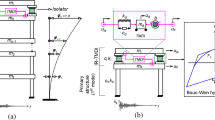Abstract
The earthquake-resistant design of prefabricated buildings is currently the focus of attention, especially for industrial buildings that require a high level of seismic protection. The standard design approach, based on ductility requirements, may succeed in preventing building collapse during a severe earthquake, but at the expense of accepting a high damage level at the column bases. To improve the seismic performance of such buildings, different innovative techniques have been proposed. However, these have not been widely implemented in engineering practice due, among others, to the lack of simple conceptual design methodologies. To achieve this goal, a methodology for the design of a roof isolation system is presented, where the roof isolation serves as non-conventional tuned mass damper (TMD), giving a significantly reduced response in terms of displacements and forces. To that effect, design expressions for the TMD period and damping, depending on the building and soil characteristics, are proposed: The expressions have been calibrated based on numerical parametric time history analyses considering Eurocode 8 spectrum—compatible accelerograms. The application of the proposed methodology is demonstrated for a two-story prefabricated building.
Similar content being viewed by others
Abbreviations
- m s :
-
Mass of the main system
- m TMD :
-
Mass of the secondary system (TMD)
- k s :
-
Stiffness of the main system
- k TMD :
-
Stiffness of the secondary system (TMD)
- c TMD :
-
Viscous damping of the secondary system (TMD)
- \({\omega_{\rm TMD}}\) :
-
Frequency of the secondary system (TMD)
- \({\omega_{\rm s}}\) :
-
Frequency of the main system
- \({{\xi }_{\rm TMD}}\) :
-
Critical damping ratio of the secondary system (TMD)
- \({{\xi }_{\rm s}}\) :
-
Critical damping ratio of the main system (structure)
- \({\alpha}\) :
-
Frequency ratio between secondary system and main system
- \({\mu}\) :
-
Mass ratio between secondary system and main system
- \({\omega}\) :
-
Frequency of the exciting force
- \({{\omega}_{{\rm g}}}\) :
-
Frequency of the ground
- \({{\xi }_{\rm g}}\) :
-
Damping ratio of the ground
- \({\Phi_{i, j}}\) :
-
Amplitude of modes normalized to return the modal participation factor equal to unity
- \({\phi_{i, j}}\) :
-
Amplitude of modal eigenvector
References
FIB: Seismic Design of Precast Concrete Building Structures. State-of-art report. FIB: Federation Internationale du beton (2004); ISBN 978-2-88394-067
Den Hartog J.P.: Mechanical Vibrations. McGraw-Hill, New York (1956)
Ayorinde E.O., Warburton G.B.: Minimizing structural vibrations with absorbers. Earthq. Eng. Struct. Dyn. 8, 219–236 (1980)
Rana R., Soong T.T.: Parametric study and simplified design of tuned mass dampers. Eng. Struct. 20, 193–204 (1998)
Tsai H.C., Lin G.C.: Optimum tuned-mass dampers for minimizing steady-state response of support-excited and damped structures. Earthq. Eng. Struct. Dyn. 16, 29–43 (1993)
Sadek F., Mohraz B., Taylor A.W., Chung R.M.: A method of estimating the parameters of tuned mass dampers for seismic applications. Earthq. Eng. Struct. Dyn. 26, 617–635 (1997)
Villaverde R.: Implementation study of aseismic roof isolation system in 13-story building. J. Seismol. Earthq. Eng. 2, 17–27 (2000)
De Angelis M., Perno S., Reggio A.: Dynamic response and optimal design of structures with large mass ratio TMD. Earthq. Eng. Struct. Dyn. 41, 41–60 (2011)
Holmes J.D.: Listing of installations. Eng. Struct. 17(9), 676–678 (1995)
Soong T.T., Dargush G.F.: Passive Energy Dissipation Systems in Structural Engineering. Wiley, New York (1997)
Soong T.T., Reinhorn A.M., Aizawa S., Higashino M.: Recent structural applications of active control technology. J. Struct. Control 1(2), 5–21 (1997)
Villaverde R.: Aseismic roof isolation system to reduce the seismic response of building: a preliminary assessment. Earthq. Spectra 14((3), 521–532 (1998)
Villaverde, R.; Mosqueda, G.: Aseismic roof isolation system: analytic and shake table studies. Earthq. Eng. Struct. Dyn. (28), 217–234 (1999)
Mellkumyan, M.: New Solution in Seismic Isolation. Lusabats, Yerevan (2011). ISBN: 978-9939-808-76-5
Mellkumyan, M.: Experimental investigation of efficiency of tuned single and double mass damper and its application in the form of an additional upper floor for seismic protection of existing multistory buildings. Constr. Eng. 1(2) (2013)
Di Sarno, L.; Wyatt, T.A.: High rise steel buildings under wind loads. In: Proceedings of the XI International Conference on Metal Structures (ICMS) Rzeszow (CD-ROM) (2006)
Tsai H.C.: The effect of tuned mass dampers on the seismic response of base-isolated structures. Int. J. Solids Struct. 32(8/9), 1195–1210 (1995)
Hoang N., Fujino Y., Warnitchai P.: Optimal tuned mass damper for seismic applications and practical design formulas. Eng. Struct. 30, 707–715 (2008)
Kanai K.: Semi-empirical formula for the seismic characteristics of the ground. Bull. Earthq. Res. Inst. Univ. Tokyo 35, 309–25 (1957)
Tajimi, H.: A statistical method of determining the maximum response of a building structure during an earthquake. In: Proceedings of the 2nd World Conference on Earthquake Engineering, vol. II, pp. 781–798
Villaverde R.: Reduction in seismic response with heavily-damped vibration absorbers. Earthq. Eng. Struct. Dyn. 13, 33–42 (1985)
Comité Européen de Normalisation, Eurocode 8: Design of Structures for Earthquake Resistance, Part 1: General Rules, Seismic Actions and Rules for Buildings. Brussels EN 1998-1:2004 E (1995)
Consiglio superiore dei lavori pubblici: New Technical Code for Constructions (in Italian) G.U. n. 29 del 4/2/2008 (2008)
Bouc, R.: Forced vibration of mechanical systems with hysteresis. In: Proceedings of the 4th Conference on Non-linear Oscillations (1967)
Wen Y.K.: Method for random vibration of hysteretic systems. J. Eng. Mech. Div. ASCE 102(2), 249–263 (1976)
Charalampakis A.E., Koumosis V.K.: A Bouc–Wen model compatible with plasticity postulates. J. Sound Vib. 322, 954–968 (2009)
CSI: SAP2000: Integrated Software for Structural Analysis and Design. University of California, Berkley (2010)
Author information
Authors and Affiliations
Corresponding author
Rights and permissions
About this article
Cite this article
Nisticò, N., Gkagka, E.E. & Gantes, C.J. Roof Isolation with Tuned Mass-based Systems and Application to a Prefabricated Building. Arab J Sci Eng 40, 431–442 (2015). https://doi.org/10.1007/s13369-014-1537-1
Received:
Accepted:
Published:
Issue Date:
DOI: https://doi.org/10.1007/s13369-014-1537-1




